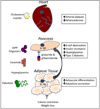Inflammasome activation in obesity-related inflammatory diseases and autoimmunity
- PMID: 21794210
- PMCID: PMC4266394
Inflammasome activation in obesity-related inflammatory diseases and autoimmunity
Abstract
The inflammasome is a highly regulated protein complex that triggers caspase-1 activation and subsequent secretion of IL-1β and IL-18. Recognition of microbial components and danger signals by NOD-like receptor (NLR) family members in the cytosol promotes inflammasome activation and downstream inflammatory cytokine production. Pathogen recognition by NLRs and downstream release of inflammasome-derived cytokines are important in host defense against numerous infections. Recent studies have also identified a unique role for inflammasome regulation in the induction and pathogenesis of multiple autoimmune and inflammatory disorders. We now know that obesity-related factors and endogenous markers of cellular stress can lead to unchecked activation of the inflammasome and provoke inflammation and subsequent destruction of vital organs. This review will highlight recent findings that link inflammasome signaling to the progression of autoinflammatory and autoimmune diseases. We will focus on the contribution of inflammasome activation to the pathogenesis of autoinflammatory and autoimmune diseases that are of major significance to human health including type 2 diabetes, atherosclerosis, multiple sclerosis, and type 1 diabetes.
Figures


References
-
- Aksentijevich I, Putnam C, Remmers EF, Mueller JL, Le J, Kolodner RD, Moak Z, Chuang M, Austin F, Goldbach-Mansky R, Hoffman HM, Kastner DL. The clinical continuum of cryopyrinopathies: novel CIAS1 mutations in North American patients and a new cryopyrin model. Arthritis Rheum. 2007;56(4):1273–1285. - PMC - PubMed
-
- Alexandraki K, Piperi C, Kalofoutis C, Singh J, Alaveras A, Kalofoutis A. Inflammatory process in type 2 diabetes: The role of cytokines. Ann N Y Acad Sci. 2006;1084:89–117. - PubMed
-
- Anderson MS, Bluestone JA. The NOD mouse: a model of immune dysregulation. Annu Rev Immunol. 2005;23:447–485. - PubMed
-
- Arend WP. The balance between IL-1 and IL-1Ra in disease. Cytokine Growth Factor Rev. 2002;13(4–5):323–340. - PubMed
Publication types
MeSH terms
Substances
Grants and funding
LinkOut - more resources
Full Text Sources
Other Literature Sources
Medical
Miscellaneous

